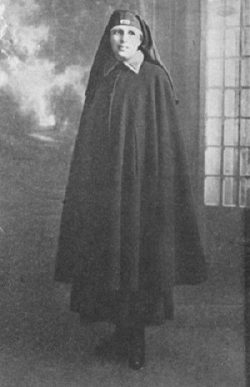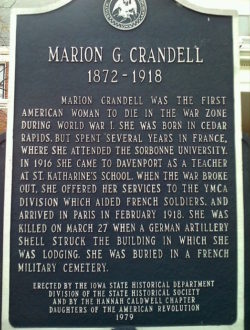 By Michael Swanger
By Michael Swanger
November 11th will mark the 100th anniversary of the end of World War I and there is no shortage of stories about Iowa’s role in it, including that of Marion G. Crandell, the Cedar Rapids native who was the first U.S. woman killed in service during the Great War on March 27, 1918. Her service and sacrifice a century ago has been largely overlooked, but is worth noting as the 100th anniversary of her death approaches.
According to websites for the Davenport Public Library and State Historical Society of Iowa, Crandell’s story unfolds as follows, though a photo of her grave marker spells her last name as “Crandall” and indicates her date of death as March 26.
Crandell was born on April 25, 1872, in Cedar Rapids. She attended school in her hometown and Omaha, Neb., before studying overseas at Sorbonne University in Paris, France. Afterwards, she lived briefly with her brother in California before returning to Iowa in 1916 to teach French at St. Katherine’s School in Davenport.
 After the U.S. declared war on Germany on April 6, 1917, Crandell decided to lend her language skills to the Allies (women were not allowed to serve in combat) and resigned from her teaching post at St. Katherine’s. She joined the United States Christian Commission of the Y.M.C.A. before her 46th birthday and after a few weeks of training she departed for France to teach French to Allied soldiers.
After the U.S. declared war on Germany on April 6, 1917, Crandell decided to lend her language skills to the Allies (women were not allowed to serve in combat) and resigned from her teaching post at St. Katherine’s. She joined the United States Christian Commission of the Y.M.C.A. before her 46th birthday and after a few weeks of training she departed for France to teach French to Allied soldiers.
When Crandell arrived in France on Feb. 15, 1918, she worked at a Y.M.C.A. canteen in Sainte-Menehould, in what was known as Le Foyer du Soldat (“soldiers’ fireside”) where soldiers could rest.
On March 27, 1918, Crandell was working near the frontline in Sainte-Menehould when German artillery began bombarding the town and a shell destroyed the building where she had sought shelter. According to the April 14 edition of The Des Moines Daily News, she died from her injuries to her arm and neck a short time later, making her the first U.S. woman killed in active service in World War I. Crandell was temporarily buried in a hospital cemetery in Sainte-Menehould before being permanently interred after the war in the Meuse-Argonne American Cemetery and Memorial.
In a letter, the director of the canteen wrote the following about Crandell’s burial:
“The American director of the Foyer at La Grande au Bois arranged for a military carriage to come for her. A chaplain of the army corps held a service in the little hut, as a chapel, draped in black. There was also there the coffin of a soldier who had been killed. Thus Miss Crandell, who came to France to serve the French soldiers, was treated as a soldier, with the same honors as for those who fell fighting. A large flag with the three colors covered her bier, and some friends had brought a crown and flowers. The same carriage and horses which are used for the soldiers, passing by side streets to avoid the sheets, took her body to the military cemetery. This was indeed her place, beside six thousand tombs of soldiers ‘dead for the country,’ Miss Crandell had ‘died for France.’ The head doctor tells me that this is the first woman buried in this vast cemetery the very sight of which moves the heart.
“The discourse of the chaplain was punctuated by the cannon. The speaker recalled that the evening before the catastrophe a Catholic aumonier (chaplain) visiting the Foyer asked if she were not afraid. Miss Crandell replied, ‘Oh, no; I pray, and after that I have no more fear.’”
 On Nov. 11, 1925, a marker commemorating Crandell was placed at the foot of the Government Bridge. Another memorial (pictured) was placed in 1979 at the Annie Wittenmyer Home (2800 Eastern Ave.) in Davenport.
On Nov. 11, 1925, a marker commemorating Crandell was placed at the foot of the Government Bridge. Another memorial (pictured) was placed in 1979 at the Annie Wittenmyer Home (2800 Eastern Ave.) in Davenport.
TO READ MORE FASCINATING STORIES ABOUT IOWA HISTORY, subscribe to Iowa History Journal. You can also purchase back issues at the store.
